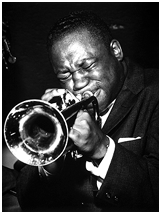![]()
![]()
![]()
![]()
![]()
![]()
Brown possessed stellar technique on his instrument. As a soloist, he preferred to stay in the “bottom and middle registers with occasional and dramatic forays into the upper register.”[1] He is most often compared to Fats Navarro, but “Brown's playing was a synthesis of elements from the Gillespie, Navarro and [Miles] Davis styles.”[2] In 1956 this sound that would become the classic embodiment of hard bop trumpet was a bit of a new concept, as one reviewer noted, “[Brown is] one of the younger trumpeters to break away from the cool sound and go back to Dizzy and Roy [Eldridge] and Navarro for inspiration....”[3] Just as Clifford brought this warm sound back in the mid-fifties, musicians two decades later would rediscover his beautiful playing.
As Joachim E. Berendt states, “...Brown's influence became noticeable again, even more strongly, at the end of the seventies with the rise of neo-bop.”[4] This movement of neo-bop found led most earnestly by New Orleans trumpeter Wynton Marsalis. The influence of Brown can be heard in Wynton's warm, round tone and rhythmic inventive bop solo lines.
Clifford's style began to be imitated almost immediately after he hit the scene, and the list of musicians that have been influenced by Brown's warm tone and lyrical style in long and impressive: “Brown's influence lives in the playing of Freddie Hubbard, Carmell Jones, Woody Shaw, Charles Tolliver, Randy Brecker and Tom Brown ([Lee] Morgan was also a disciple).”[5] Cuban trumpet virtuoso Arturo Sandoval is mostly known for his association with Dizzy Gillespie, but in 1992 he recorded a tribute Brownie called I Remember Clifford. For this album, which he “considers his best,” he was given a letter of thanks from Brown's widow.[6]
Clifford is now considered one of the greatest trumpeters ever and a figure of reverence among musicians, but this is no new occurrence. He began receiving critical praise as soon as he hit the jazz scene. In 1954, Nat Hentoff stated, “The word among musicians both here and in Europe is that a new Dizzy Gillespie has arrived.”[7] Immediately following Brown's death Horace Silver said he was “without a doubt ... the greatest trumpeter to hit scene in the last five years.”[8] He was so well thought of not just for his lovely playing, but also his beautiful spirit.
[1]David Baker, The Jazz Style of Clifford Brown: A Musical and Historical Perspective (Hialeah, Florida: Columbia Pictures Publications, 1982), 11.
[2]West, 30.
[3]Jack Tracy, “Clifford Brown-Max Roach,” review of Clifford Brown and Max Roach at Basin Street, by Clifford Brown-Max Roach Quintet, Downbeat, 19 September 1956, 23.
[4]Joachim E. Berendt, The Jazz Book: From Ragtime to Fusion and Beyond (Westport, Connecticut: Lawrence Hill and Co., Inc., 1975), 171.
[5]West, 30.
[6]Howard Mandel, “Arturo Sandoval Comes Out Swingin',” Downbeat. October 1996, 18.
[7]Nat Hentoff, “Clifford Brown—The New Dizzy,” Downbeat, 7 April 1954, 15.
[8]Horace Silver, “A Tribute To Brownie,” Downbeat, 22 August 1956, 10.
